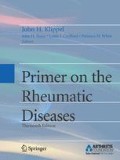Abstract
-
Glucocorticoids (GCs) have powerful anti-inflammatory and immunomodulatory effects and are useful for treating many rheumatic diseases.
-
Glucocorticoids work by inhibiting leukocyte access to infl amed tissues, interfering with the function of cells involved in the infl ammatory process, and suppressing the production of humoral factors such as cytokines and prostaglandins involved in immune infl ammatory processes.
-
Glucocorticoids accomplish their effects by several mechanisms, including altering synthesis of proteins, releasing proteins from intracellular protein complexes that include GC receptors, and changing the properties of biological membranes.
-
Initial GC dosage should be determined by the type and severity of the disease manifestation under treatment.
-
■ Because of signifi cant toxicity associated with long-term GC use, doses of <7.5 mg daily are recommended only if required to control symptoms.
Access this chapter
Tax calculation will be finalised at checkout
Purchases are for personal use only
Preview
Unable to display preview. Download preview PDF.
References
Thiele K, Buttgereit F, Zink A. Current use of glucocorticoids in patients with rheumatoid arthritis in Germany. Arthritis Rheum 2005;53:740–747.
Buttgereit F, Straub RH, Wehling M, Burmester GR. Glucocorticoids in the treatment of rheumatic diseases. An update on mechanisms of action. Arthritis Rheum 2004;50:3408–3417.
Rhen T, Cidlowski JA. Antiinflammatory action of glucocorticoids-new mechanisms for old drugs. N Engl J Med 2005;353:1711–1723.
Buttgereit F, Burmester GR, Lipworth BJ. Optimised glucocorticoid therapy: the sharpening of an old spear. Lancet 2005;375:801–803.
Buttgereit F, da Silva JA, Boers M, et al. Standardised nomenclature for glucocorticoid dosages and glucocorticoid treatment regimens: current questions and tentative answers in rheumatology. Ann Rheum Dis 2002;61:718–722.
Adcock IM, Lane SJ. Mechanisms of steroid action and resistance in inflammation. Corticosteroid-insensitive asthma: molecular mechanisms. J Endocrinol 2003;178:347–355.
Goulding NJ, Flower RJ. Glucocorticoid biology-a molecular maze and clinical challenge. In: Goulding NJ, Flower RJ, eds. Milestones in drug therapy: glucocorticoids. Basel: Birkhäuser Verlag; 2001:5.
Buttgereit F, Saag K, Cutolo M, da Silva JAP, Bijlsma JWJ. The molecular basis for the effectiveness, toxicity, and resistance to glucocorticoids: focus on the treatment of rheumatoid arthritis. Scand J Rheum 2005;34:14–21.
Croxtall JD, Choudhury Q, Flower RJ. Glucocorticoids act within minutes to inhibit recruitment of signalling factors to activated EGF receptors through a receptor-dependent, transcription-independent mechanism. Br J Pharmacol 2000;130:289–298.
Kirwan JR. The effect of glucocorticoids on joint destruction in rheumatoid arthritis. The Arthritis and Rheumatism Council Low-Dose Glucocorticoid Study Group. N Engl J Med 1995;333:142–146.
Boers M, Verhoeven AC, Markusse HM, et al. Randomised comparison of combined step-down prednisolone, methotrexate and sulfasalazine with sulfasalazine alone in early rheumatoid arthritis. Lancet 1997;350:309–318.
Landewe RB, Boers M, Verhoeven AC, et al. COBRA combination therapy in patients with early rheumatoid arthritis: long-term structural benefi ts of a brief intervention. Arthritis Rheum 2002;46:347–356.
Van Everdingen AA, Jacobs JW, Siewertsz Van Reesema DR, Bijlsma JW. Low-dose prednisone therapy for patients with early active rheumatoid arthritis: clinical effi cacy, disease-modifying properties, and side effects: a randomized, double-blind, placebo-controlled clinical trial. Ann Intern Med 2002;136:1–12.
Wassenberg S, Rau R, Steinfeld P, Zeidler H. Very lowdose prednisolone in early rheumatoid arthritis retards radiographic progression over two years: a multicenter, double-blind, placebo-controlled trial. Arthritis Rheum 2005;52:3371–3380.
Svensson B, Boonen A, Albertsson K, van der Heijde D, Keller C, Hafstrom I. Low-dose prednisolone in addition to the initial disease-modifying antirheumatic drug in patients with early active rheumatoid arthritis reduces joint destruction and increases the remission rate: a two-year randomized trial. Arthritis Rheum 2005;52:3360–3370.
Da Silva JA, Jacobs JW, Kirwan JR, et al. Safety of low dose glucocorticoid treatment in rheumatoid arthritis: published evidence and prospective trial data. Ann Rheum Dis 2006;65:285–293.
Iwamoto J, Takeda T, Ichimura S. Forearm bone mineral density in postmenopausal women with rheumatoid arthritis. Calcif Tissue Int 2002;70:1–8.
Metselaar JM, Wauben MH, Wagenaar-Hilbers JP, Boerman OC, Storm G. Complete remission of experimental arthritis by joint targeting of glucocorticoids with long-circulating liposomes. Arthritis Rheum 2003;48:2059–2066.
Paul-Clark MJ, Mancini L, Del Soldato P, Flower RJ, Perretti, M. Potent antiarthritic properties of a glucocorticoid derivative, NCX-1015, in an experimental model of arthritis. Proc Natl Acad Sci U S A 2002;99:1677–1682.
Schacke H, Döcke WD, Asadullah K. Mechanisms in-volved in the side effects of glucocorticoids. Pharm Ther 2002;96:23–43.
Schacke H, Schottelius A, Döcke W, et al. Dissociation of transactivation from transrepression by a selective gluco corticoid receptor agonist leads to separation of therapeutic effects from side effects. Proc Natl Acad Sci U S A. 2004;101:227–232.
Miner JN. Designer glucocorticoids. Biochem Pharmacol 2002;64:355–361.
Coghlan MJ, Jacobson PB, Lane B, et al. A novel anti-inflammatory maintains glucocorticoid effi cacy with reduced side effects. Mol Endocrinol 2003;17:860–869.
Author information
Authors and Affiliations
Editor information
Editors and Affiliations
Rights and permissions
Copyright information
© 2008 Springer Science+Business Media, LLC.
About this chapter
Cite this chapter
Buttgereit, F., Burmester, GR. (2008). Glucocorticoids. In: Klippel, J.H., Stone, J.H., Crofford, L.J., White, P.H. (eds) Primer on the Rheumatic Diseases. Springer, New York, NY. https://doi.org/10.1007/978-0-387-68566-3_84
Download citation
DOI: https://doi.org/10.1007/978-0-387-68566-3_84
Publisher Name: Springer, New York, NY
Print ISBN: 978-0-387-35664-8
Online ISBN: 978-0-387-68566-3
eBook Packages: MedicineMedicine (R0)

